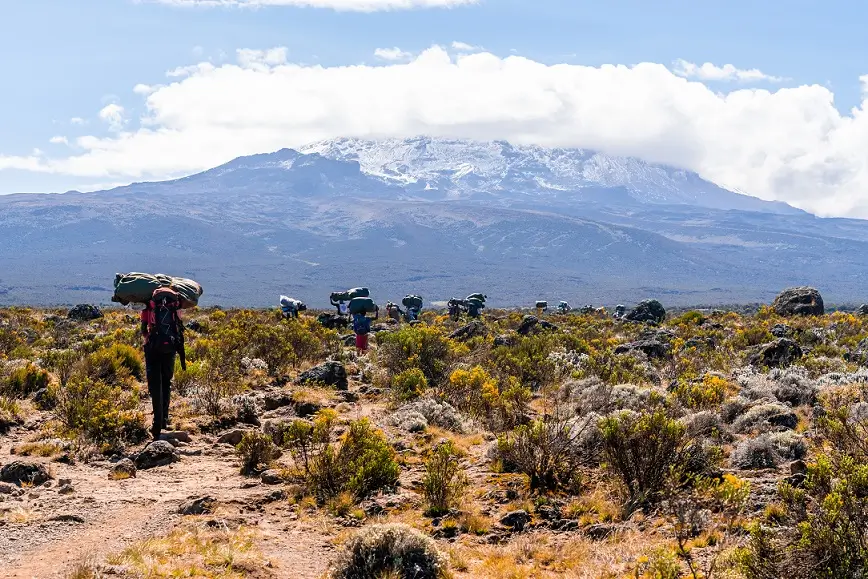Mount Kilimanjaro, known as the “Roof of Africa,” is a stunning volcanic giant in northern Tanzania. Standing at 5,895 meters, it’s the highest peak on the African continent. Every year, trekkers and nature lovers travel here to witness its snow-capped summit and diverse ecosystems. But beyond its beauty, there are many fascinating facts about Mount Kilimanjaro that reveal why it’s one of the world’s most iconic mountains.
In this blog post, we’ll explore five captivating facts about this majestic mountain that make it a must-visit destination for those seeking physical and spiritual challenges.
Let’s go through 5 facts about Mount Kilimanjaro.
Mount Kilimanjaro, located in Tanzania, is Africa’s tallest peak and one of the most iconic and sought-after destinations for trekkers and adventure enthusiasts worldwide. Rising majestically above the African savannah, Kilimanjaro offers an awe-inspiring adventure combining breathtaking landscapes and a sense of accomplishment. This blog post will delve into five intriguing facts about Mount Kilimanjaro that make it a must-visit destination.
Africa’s Highest Freestanding Mountain
Mount Kilimanjaro is Africa’s tallest freestanding mountain, soaring to an impressive height of 19,341 feet (5,895 meters) above sea level. Unlike many other prominent peaks that are part of mountain ranges, Kilimanjaro stands alone, making it a true natural wonder. This unique distinction contributes to its popularity among trekkers and mountaineers seeking to ascend a standalone summit.
Read About the Height of Mt Kilimanjaro
Diverse Climatic Zones in One Ascent
One of the most remarkable features of climbing Kilimanjaro is the diverse range of climatic zones you’ll encounter on your ascent. Starting in the lush rainforests at the mountain’s base, trekkers progress through different ecological zones, including moorlands, alpine deserts, and glacial areas. This variation in environments means you’ll experience various temperatures and ecosystems during your journey to the summit.
Uhuru Peak: The Roof of Africa
The highest point on Mount Kilimanjaro is Uhuru Peak, which stands at an elevation of 19,341 feet (5,895 meters). Reaching Uhuru Peak is the ultimate goal for climbers, and it offers breathtaking panoramic views of the surrounding landscapes. The sense of accomplishment that comes with standing on the “Roof of Africa” is a profound and unforgettable experience.
Kilimanjaro’s Glaciers are Receding
Kilimanjaro is known for its iconic glaciers, which have been a part of its landscape for thousands of years. However, due to the effects of climate change, these glaciers are receding at an alarming rate. Scientists estimate that they may disappear entirely within a few decades. This makes climbing Kilimanjaro an even more urgent and meaningful endeavor, as it offers a firsthand view of the consequences of climate change.
Various Routes to the Summit
There are several routes to the summit of Kilimanjaro, each offering a unique experience in terms of scenery, difficulty, and duration. The most popular courses include the Machame Route, Lemosho Route, Marangu Route, and the challenging Umbwe Route. The choice of course depends on your fitness level, trekking experience, and the type of adventure you seek.
FAQs About Facts Related to Mount Kilimanjaro
1. How tall is Mount Kilimanjaro?
Mount Kilimanjaro stands at 5,895 meters (19,341 feet), making it the tallest mountain in Africa.
2. Is Mount Kilimanjaro a volcano?
Yes, it’s a dormant volcano with three cones—Kibo, Mawenzi, and Shira. Kibo is the highest and most well-known.
3. Does Mount Kilimanjaro have snow?
Yes, the summit has glaciers and snow, though they are slowly shrinking due to climate change.
4. Can beginners climb Mount Kilimanjaro?
Yes, with proper preparation. It’s a non-technical trek, so no climbing gear is needed, but altitude can be challenging.
5. How many ecosystems does Kilimanjaro have?
Mount Kilimanjaro has five distinct climate zones—from rainforest to alpine desert and arctic summit.
Conclusion
Climbing Mount Kilimanjaro is a remarkable journey combining physical challenges and breathtaking natural beauty. Whether you’re drawn to the idea of standing on the “Roof of Africa” or witnessing the ecological changes happening on the mountain, Kilimanjaro offers an adventure like no other. It’s a trek that will not only test your physical limits but also leave you with a profound appreciation for the majesty of nature and the importance of preserving our planet’s delicate ecosystems.
Going through the above 5 facts about Mount Kilimanjaro there are many other reasons why climbing Kilimanjaro should come to your bucketlist.




